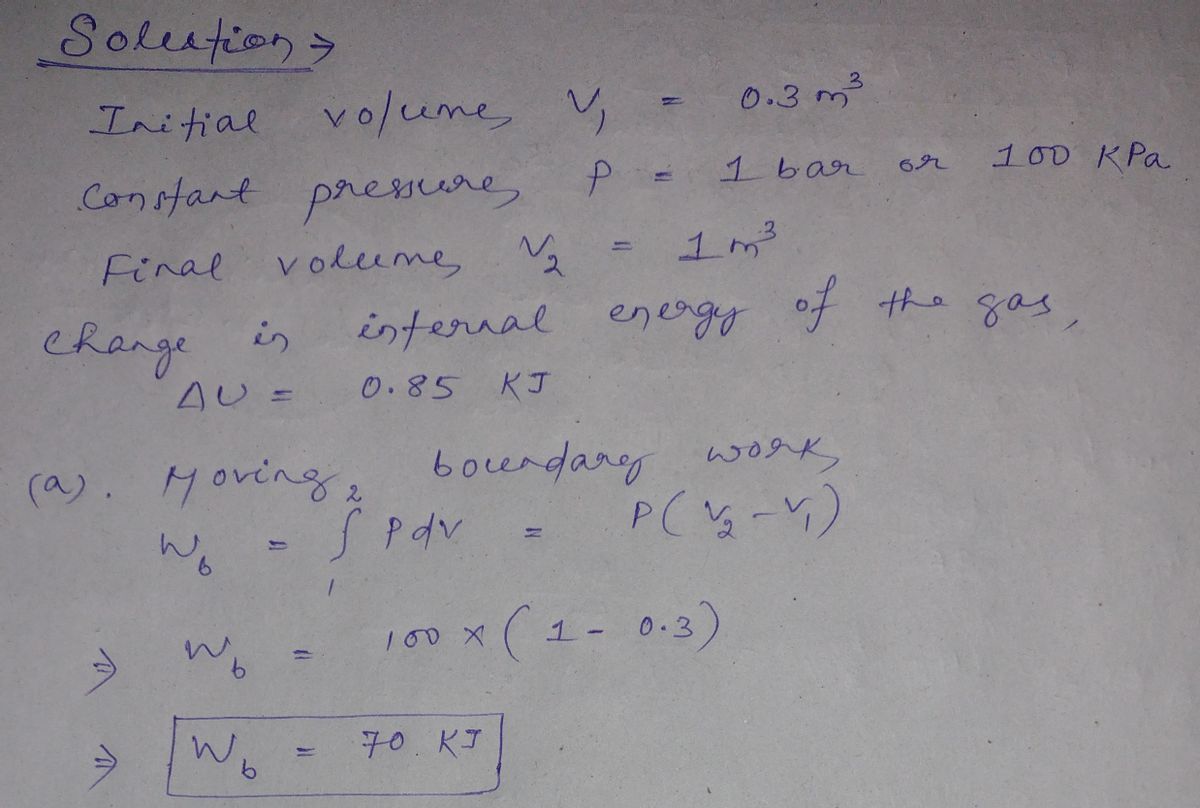A gas contained within a simple piston-cylinder assembly with a fixed piston mass, initially at a volume of 0.3 m³, undergoes a quasi-equilibrium expansion at 1 bar to a final volume of 1 m³, while being slowly heated through the base. The change in internal energy of the gas is 0.85 kJ. The piston and cylinder walls are fabricated from heat-resistant materials for thermal insulation, and the piston moves smoothly in the cylinder without friction. By taking the gas as the system, (a) find the moving boundary work (W₁ = ₁² PdV) done by the gas, in kJ, and (b) the heat transfer between the system and its surroundings, in kJ.
A gas contained within a simple piston-cylinder assembly with a fixed piston mass, initially at a volume of 0.3 m³, undergoes a quasi-equilibrium expansion at 1 bar to a final volume of 1 m³, while being slowly heated through the base. The change in internal energy of the gas is 0.85 kJ. The piston and cylinder walls are fabricated from heat-resistant materials for thermal insulation, and the piston moves smoothly in the cylinder without friction. By taking the gas as the system, (a) find the moving boundary work (W₁ = ₁² PdV) done by the gas, in kJ, and (b) the heat transfer between the system and its surroundings, in kJ.
Elements Of Electromagnetics
7th Edition
ISBN:9780190698614
Author:Sadiku, Matthew N. O.
Publisher:Sadiku, Matthew N. O.
ChapterMA: Math Assessment
Section: Chapter Questions
Problem 1.1MA
Related questions
Question

Transcribed Image Text:A gas contained within a simple piston-cylinder assembly with a fixed piston mass, initially
at a volume of 0.3 m³, undergoes a quasi-equilibrium expansion at 1 bar to a final volume of
1 m³, while being slowly heated through the base. The change in internal energy of the gas is
0.85 kJ. The piston and cylinder walls are fabricated from heat-resistant materials for thermal
insulation, and the piston moves smoothly in the cylinder without friction. By taking the gas
as the system, (a) find the moving boundary work (W₁ = ₁² PdV) done by the gas, in kJ, and
(b) the heat transfer between the system and its surroundings, in kJ.
Expert Solution
Step 1

Step by step
Solved in 2 steps with 2 images

Knowledge Booster
Learn more about
Need a deep-dive on the concept behind this application? Look no further. Learn more about this topic, mechanical-engineering and related others by exploring similar questions and additional content below.Recommended textbooks for you

Elements Of Electromagnetics
Mechanical Engineering
ISBN:
9780190698614
Author:
Sadiku, Matthew N. O.
Publisher:
Oxford University Press

Mechanics of Materials (10th Edition)
Mechanical Engineering
ISBN:
9780134319650
Author:
Russell C. Hibbeler
Publisher:
PEARSON

Thermodynamics: An Engineering Approach
Mechanical Engineering
ISBN:
9781259822674
Author:
Yunus A. Cengel Dr., Michael A. Boles
Publisher:
McGraw-Hill Education

Elements Of Electromagnetics
Mechanical Engineering
ISBN:
9780190698614
Author:
Sadiku, Matthew N. O.
Publisher:
Oxford University Press

Mechanics of Materials (10th Edition)
Mechanical Engineering
ISBN:
9780134319650
Author:
Russell C. Hibbeler
Publisher:
PEARSON

Thermodynamics: An Engineering Approach
Mechanical Engineering
ISBN:
9781259822674
Author:
Yunus A. Cengel Dr., Michael A. Boles
Publisher:
McGraw-Hill Education

Control Systems Engineering
Mechanical Engineering
ISBN:
9781118170519
Author:
Norman S. Nise
Publisher:
WILEY

Mechanics of Materials (MindTap Course List)
Mechanical Engineering
ISBN:
9781337093347
Author:
Barry J. Goodno, James M. Gere
Publisher:
Cengage Learning

Engineering Mechanics: Statics
Mechanical Engineering
ISBN:
9781118807330
Author:
James L. Meriam, L. G. Kraige, J. N. Bolton
Publisher:
WILEY